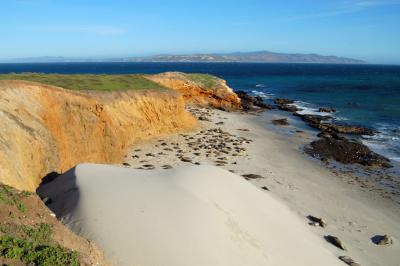In 2022, Aaron Angel completed the California Sea Grant State Fellowship. This program provides fellows with hands-on training with either a municipal, state or federal host agency in California. Over the course of 12 months, fellows work at the intersection of science, policy, communication and management. During her fellowship, Aaron worked with the Planning and Performance Division for the Delta Stewardship Council. Upon completion of her fellowship, she accepted a position as an environmental scientist in the Delta Stewardship Council’s Science Division. Here, she talks about her experience in the fellowship program and some of the issues she worked on along the way.
Our society is intrinsically linked to the environment that surrounds us. However, significant changes to the landscape from agricultural and industrial development have led to the need for active natural resource management to help maintain the structure and function of ecosystems. It was not always this way.

Natural resource management by Indigenous communities prior to the Western colonial settlement of California was critical in shaping both the physical landscape and human behavior. Indigenous management relies heavily on concepts of interdependence and the responsibility of human communities to the ecological ecosystems they inhabit. Settler colonization and the displacement of Native communities led to the disruption of the human relationship with the environment. Some argue that this led to an approach to environmental management that focuses on non-human aspects of ecosystems.
In line with this, the scientific community and natural resources managers have been working to understand how to better integrate human factors into present-day management and monitoring of ecosystems, rather than focusing narrowly on measurements of the physical and non-human environment.
While we cannot turn back time and undo the significant alterations to the landscape that have cumulated over centuries, we can improve the way we relate to our environment. In doing so, we may be able to build upon existing ecologically focused monitoring and management efforts to holistically manage socio-ecological systems in a more sustainable, effective and equitable way.
Ecological and Social Monitoring
Ecological monitoring is important for tracking ecosystem health, including essential resources for both humans and other species. Many federal and state agencies, as well as non-governmental organizations, conduct ecological monitoring as required by regulations (various assembly bills, Coastal Act, Federal Endangered Species Act), thereby supporting adaptive management efforts. Ecological indicators are those that demonstrate larger trends in ecosystem health, such as species diversity and health. However, evaluating ecological indicators alone can overlook important conditions of human actors and may miss the opportunity to understand how environmental conditions directly relate to human behavior, well-being and health. Integrating social monitoring and metrics can strengthen the applicability of ecological data for effective management decisions.
For instance, social indicators such as public water supply, cultural resource use and recreational use demonstrate the health of the community and can demonstrate community vulnerability to ecosystem drivers — direct influencers of biodiversity and ecosystem change. By including linked social and ecological indicators in efforts to manage natural resources, we can better understand the entire ecosystem.
For example, managers may want to track the effectiveness of large-scale ecosystem restoration projects. Historically, this has often been done by tracking ecological metrics such as species diversity or hydrologic channel sinuosity. However, tracking social indicators such as recreational activity and community perceptions of restoration in tandem with ecological data may provide useful insights into the success of a restoration project.
Creating a Database
In 2022, a team of graduate students from UC Davis’ Environmental Policy and Management program and California Sea Grant extension specialists conducted an assessment of social and ecological indicator integration in California state agency monitoring programs. The aim was to understand how widespread integration of social and ecological monitoring efforts were and where major gaps remain. A living database comprising over 300 individual social, ecological and social-ecological indicators from 40 programs in 21 agencies was created and is currently hosted on California Sea Grant’s website. It also houses important information such as definitions, indicator impact, research methods and program information.
This project presents an exciting opportunity to identify the baseline of social and social-ecological indicator integration in monitoring programs across the state. It highlights special cases that are more advanced in their implementation, providing a wealth of lessons learned that can be shared with other ongoing programs or those currently in the planning phase.
As a California Sea Grant State Fellow, I had the opportunity to contribute to this project as an extension of the work I was doing in my placement in the Planning and Performance Division at the Delta Stewardship Council. The Sacramento-San Joaquin Delta is a complex and highly integrated system with many uses, including water resources, agriculture, ecosystem restoration and recreation. The Delta community is passionate and active in the management process, attending public meetings and workshops to provide feedback to the Council and partner agencies in the region.
In this unique role, I witnessed the importance of social variables in the management of this system. The value of managing the Delta as a social-ecological system is built into the Council’s mission to advance California’s coequal goals — a more reliable water supply and a resilient Delta ecosystem — in a manner that protects and enhances the unique characteristics of the Delta as an evolving place where people live, work and recreate. Recently, the Council has taken action to integrate a social-ecological systems perspective into management, science and policy processes (learn more about the Delta Social Science Task Force and Community of Practice efforts).
While this process is challenging in that it departs from the ‘way things are usually done,’ it exemplifies the importance of understanding and including a critical piece of the system — the people.
Moving Forward
Working on this project opened up a new world of science for me. I was initially interested in contributing because I had no prior social science training. After doing a deep dive into the database and project summary the UC Davis graduate group prepared, I refined the scope of the project to only include coastal and watershed monitoring programs. I used a semi-structured interview approach and met with representatives from the California Environmental Protection Agency and the California Natural Resources Agency Open Data Portal to gain a better understanding of how departments within these agencies structure their coastal/watershed monitoring programs throughout California.
Overall, there was substantial interest in the idea of a central database that contained monitoring data from different resource management agencies, including useful tags that would make searching for social and social-ecological monitoring programs easily accessible. There are familiar challenges to this approach, including a lack of sufficient resources to compile and categorize data and a shared methodology for consistent data reporting and terminology use across agencies. Future efforts could include convening related monitoring program representatives to coordinate and learn from one another, collect missing data, and identify best practices, challenges and opportunities for implementing coordinated and inter-operable programs. The knowledge could be summarized and key recommendations crafted on how to best integrate social-ecological indicators in monitoring programs statewide for sustainable, effective and equitable natural resource management.
As we begin to understand social-ecological integration better in the context of management, we may also begin to recognize how essential human connection is to the success of our management decisions. Exemplary cases, such as the Channel Islands Marine Protected Areas (see attachment below), demonstrate the usefulness of the relationship between social and environmental factors in real-world management applications.

From cases like these, we learn the importance of consistently collecting social and ecological monitoring data so that trends can be captured, reported and interpreted in a way that increases the effectiveness of our management decisions. If we are to manage our landscapes as social-ecological systems, a shared methodology for reporting data and commitment to information exchange across monitoring programs statewide is paramount. Implications of the monitoring trends to the program, agency and community goals should be clearly communicated and used to adapt ongoing ecosystem-based management efforts. In doing so, we may be able to gradually restore a more sustainable relationship with the environment and more effective and equitable natural resource management.
About California Sea Grant
NOAA’s California Sea Grant College Program funds marine research, education and outreach throughout California. Headquartered at Scripps Institution of Oceanography at the University of California San Diego, California Sea Grant is one of 34 Sea Grant programs in the National Oceanic and Atmospheric Administration (NOAA), U.S. Department of Commerce.